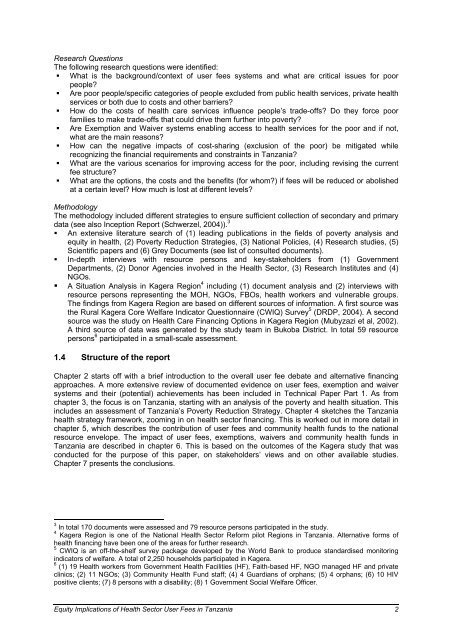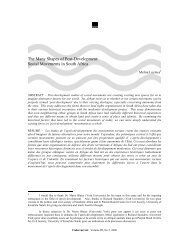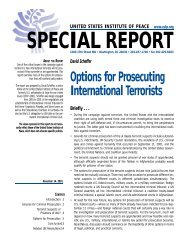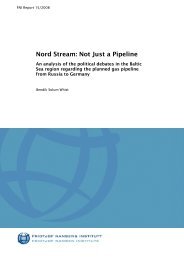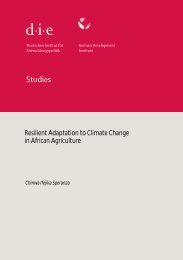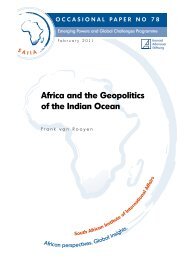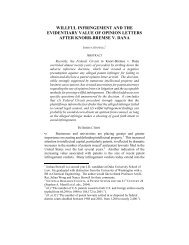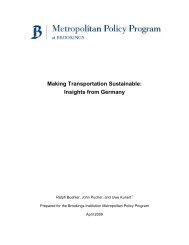equity implications of health sector user fees in tanzania
equity implications of health sector user fees in tanzania
equity implications of health sector user fees in tanzania
Create successful ePaper yourself
Turn your PDF publications into a flip-book with our unique Google optimized e-Paper software.
Research Questions<br />
The follow<strong>in</strong>g research questions were identified:<br />
� What is the background/context <strong>of</strong> <strong>user</strong> <strong>fees</strong> systems and what are critical issues for poor<br />
people?<br />
� Are poor people/specific categories <strong>of</strong> people excluded from public <strong>health</strong> services, private <strong>health</strong><br />
services or both due to costs and other barriers?<br />
� How do the costs <strong>of</strong> <strong>health</strong> care services <strong>in</strong>fluence people’s trade-<strong>of</strong>fs? Do they force poor<br />
families to make trade-<strong>of</strong>fs that could drive them further <strong>in</strong>to poverty?<br />
� Are Exemption and Waiver systems enabl<strong>in</strong>g access to <strong>health</strong> services for the poor and if not,<br />
what are the ma<strong>in</strong> reasons?<br />
� How can the negative impacts <strong>of</strong> cost-shar<strong>in</strong>g (exclusion <strong>of</strong> the poor) be mitigated while<br />
recogniz<strong>in</strong>g the f<strong>in</strong>ancial requirements and constra<strong>in</strong>ts <strong>in</strong> Tanzania?<br />
� What are the various scenarios for improv<strong>in</strong>g access for the poor, <strong>in</strong>clud<strong>in</strong>g revis<strong>in</strong>g the current<br />
fee structure?<br />
� What are the options, the costs and the benefits (for whom?) if <strong>fees</strong> will be reduced or abolished<br />
at a certa<strong>in</strong> level? How much is lost at different levels?<br />
Methodology<br />
The methodology <strong>in</strong>cluded different strategies to ensure sufficient collection <strong>of</strong> secondary and primary<br />
data (see also Inception Report (Schwerzel, 2004)). 3<br />
� An extensive literature search <strong>of</strong> (1) lead<strong>in</strong>g publications <strong>in</strong> the fields <strong>of</strong> poverty analysis and<br />
<strong>equity</strong> <strong>in</strong> <strong>health</strong>, (2) Poverty Reduction Strategies, (3) National Policies, (4) Research studies, (5)<br />
Scientific papers and (6) Grey Documents (see list <strong>of</strong> consulted documents).<br />
� In-depth <strong>in</strong>terviews with resource persons and key-stakeholders from (1) Government<br />
Departments, (2) Donor Agencies <strong>in</strong>volved <strong>in</strong> the Health Sector, (3) Research Institutes and (4)<br />
NGOs.<br />
� A Situation Analysis <strong>in</strong> Kagera Region 4 <strong>in</strong>clud<strong>in</strong>g (1) document analysis and (2) <strong>in</strong>terviews with<br />
resource persons represent<strong>in</strong>g the MOH, NGOs, FBOs, <strong>health</strong> workers and vulnerable groups.<br />
The f<strong>in</strong>d<strong>in</strong>gs from Kagera Region are based on different sources <strong>of</strong> <strong>in</strong>formation. A first source was<br />
the Rural Kagera Core Welfare Indicator Questionnaire (CWIQ) Survey 5 (DRDP, 2004). A second<br />
source was the study on Health Care F<strong>in</strong>anc<strong>in</strong>g Options <strong>in</strong> Kagera Region (Mubyzazi et al, 2002).<br />
A third source <strong>of</strong> data was generated by the study team <strong>in</strong> Bukoba District. In total 59 resource<br />
persons 6 participated <strong>in</strong> a small-scale assessment.<br />
1.4 Structure <strong>of</strong> the report<br />
Chapter 2 starts <strong>of</strong>f with a brief <strong>in</strong>troduction to the overall <strong>user</strong> fee debate and alternative f<strong>in</strong>anc<strong>in</strong>g<br />
approaches. A more extensive review <strong>of</strong> documented evidence on <strong>user</strong> <strong>fees</strong>, exemption and waiver<br />
systems and their (potential) achievements has been <strong>in</strong>cluded <strong>in</strong> Technical Paper Part 1. As from<br />
chapter 3, the focus is on Tanzania, start<strong>in</strong>g with an analysis <strong>of</strong> the poverty and <strong>health</strong> situation. This<br />
<strong>in</strong>cludes an assessment <strong>of</strong> Tanzania’s Poverty Reduction Strategy. Chapter 4 sketches the Tanzania<br />
<strong>health</strong> strategy framework, zoom<strong>in</strong>g <strong>in</strong> on <strong>health</strong> <strong>sector</strong> f<strong>in</strong>anc<strong>in</strong>g. This is worked out <strong>in</strong> more detail <strong>in</strong><br />
chapter 5, which describes the contribution <strong>of</strong> <strong>user</strong> <strong>fees</strong> and community <strong>health</strong> funds to the national<br />
resource envelope. The impact <strong>of</strong> <strong>user</strong> <strong>fees</strong>, exemptions, waivers and community <strong>health</strong> funds <strong>in</strong><br />
Tanzania are described <strong>in</strong> chapter 6. This is based on the outcomes <strong>of</strong> the Kagera study that was<br />
conducted for the purpose <strong>of</strong> this paper, on stakeholders’ views and on other available studies.<br />
Chapter 7 presents the conclusions.<br />
3 In total 170 documents were assessed and 79 resource persons participated <strong>in</strong> the study.<br />
4 Kagera Region is one <strong>of</strong> the National Health Sector Reform pilot Regions <strong>in</strong> Tanzania. Alternative forms <strong>of</strong><br />
<strong>health</strong> f<strong>in</strong>anc<strong>in</strong>g have been one <strong>of</strong> the areas for further research.<br />
5 CWIQ is an <strong>of</strong>f-the-shelf survey package developed by the World Bank to produce standardised monitor<strong>in</strong>g<br />
<strong>in</strong>dicators <strong>of</strong> welfare. A total <strong>of</strong> 2,250 households participated <strong>in</strong> Kagera.<br />
6 (1) 19 Health workers from Government Health Facilities (HF), Faith-based HF, NGO managed HF and private<br />
cl<strong>in</strong>ics; (2) 11 NGOs; (3) Community Health Fund staff; (4) 4 Guardians <strong>of</strong> orphans; (5) 4 orphans; (6) 10 HIV<br />
positive clients; (7) 8 persons with a disability; (8) 1 Government Social Welfare Officer.<br />
Equity Implications <strong>of</strong> Health Sector User Fees <strong>in</strong> Tanzania 2


